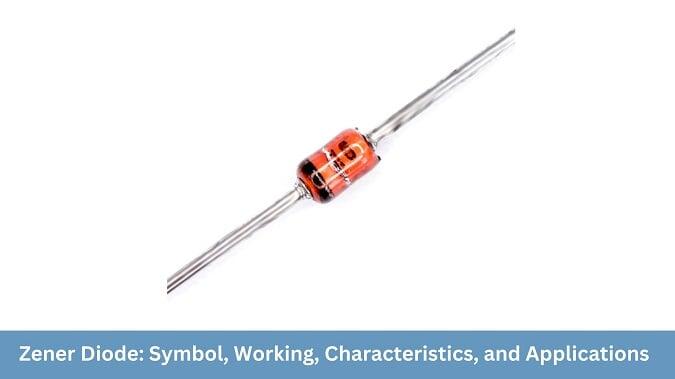
What is a Zener Diode?
A semiconductor diode, zener diode, is designed which allow current to flow in both directions (forward as well as reverse direction) when the voltage is greater than the specific voltage, which is known as the zener breakdown voltage. It is used in the microcontrollers for protecting GPIO pins by acting as voltage shifters, by interfacing 5V sensors with 3.3V microcontrollers. Zener diode acts as a precision voltage reference in many electronic components like analog ICs, op-amps, transistors, and digital ICs. As the cost of a zener diode is low, it is widely used in embedded systems, development boards, and sensor interfacing circuits.
Symbol and Construction of Zener Diode
Knowing the symbol and the construction of the Zener diode is essential for working with circuit design, embedded systems, and electronic components:
The symbol of the Zener Diode Consists of:
Anode (A): connected to the negative side. Cathode (C): Connected to the positive side when in reverse bias. The bent bar at the cathode indicates Zener functionality.
The Structure of Zener Diode
The p-type and n-type regions of zener diode are heavily doped to create a narrow depletion region which allows the diode to support zener breakdown at lower voltages (2.4v to 200v) and the junction is enclosed in aplastic or glass package, depending on power ratings.
Types of Zener Diode
1. Low-Voltage Zener Diodes
These types of diodes operate at breakdown voltages below 5V. They are used in a circuit to protect components like microcontrollers, sensors, and analog ICs, which require protection from minor overvoltage conditions. They are used in voltage reference circuits and logic level shifting.
2. High-Voltage Zener Diodes
These types of zener diodes have the breakdown voltage greater than 50V or even up to several hundred volts. These diodes can handle large power dissipation and offer stable regulation in high-energy environments. They are used in power supply protection, motor controller circuits, and industrial electronics where over-voltage risks are higher.
3. Surface Mount Zener Diode
These types of zener diodes are also called SMD zener diodes. They are compact, lightweight, and designed for automated PCB assembly. Mostly, they are used in modern embedded devices, smart IoT devices, and portable gadgets where space saving and reliability are critical.
4. Temperature Compensated Zener Diodes
These types of zener diodes are used to maintain a stable breakdown voltage over a wide temperature range. They are mostly used in the precision analog circuits, voltage references, and sensor interfaces, where thermal variation may affect performance. TO balance the temperature, they often combine zener and forward-bias diodes.
5. Precision Zener Diode
These types of diodes are mostly used in calibration circuits, analog-to-digital circuits (ADC), and regulated voltage sources in measurements. They are manufactured to offer very accurate and stable breakdown voltages. Their high voltage tolerance makes them reliable for high-accuracy applications.
Zener Diode Circuit Diagram
In the circuit diagram, The anode of the Zener diode connects to the negative side of the supply. The cathode connects to the positive side through the load. A resistor is placed in series with the power source to prevent excessive current. The above configuration is widely used in voltage regulator circuits for microcontroller power inputs, analog sensors etc.
Zener Diode Functions
- Voltage regulation is the main feature of the Zener diode. Despite the variation in input voltage, it maintains a constant output voltage, which makes it better for use in DC power supply circuits, battery-operated devices, and microcontroller-based systems.
- It acts as an overvoltage protector and protects sensitive components like ICs, sensors, microcontrollers, and transistors from overvoltage. A diode conducts the current in the reverse direction when the voltage exceeds the zener breakdown voltage.
- Zener diodes are used for waveform clipping in signal processing circuits.
- In logic circuits and timing applications, zener diodes act as a switch. By exploiting the breakdown characteristics, they allow for controlled switching.
- Zener diode helps in maintaining a steady voltage across the load in the circuits with varying load conditions.
Working Principle of Zener Diode
Below breakdown voltage, zener diode blocks current just like normal diodes. Zener diode allows the current to flow in reverse direction when the applied voltage exceeds a specific value i.e. zener breakdown voltage. This breakdown occurs due to a strong electric field across the narrow depletion region created by heavy doping on both P and N sides. There are two types of breakdown: zener breakdown (due to quantum tunnelling) and avalanche breakdown (due to collision ionization). Zener diodes are selected based on required breakdown voltage ratings, ranging from 2.4V to several hundred volts.

